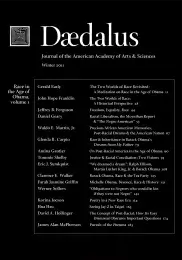The Two Worlds of Race: A Historical Perspective
Franklin’s essay traces the practices, policies, and laws that, from colonial times through the mid-1960s moment when he composed his essay, created and sustained the two worlds of race in America. He outlines the history of efforts from that period to alleviate racial distinctions and to foster a “world of equality and complete human fellowship.” Franklin cautions, however, that even certain well-intentioned efforts to extend services, opportunities, and rights to African Americans sometimes reinforced segregation and discrimination. He considers how key historical, legal, political, and social developments from the twentieth century - World War II, the growth of labor unions, the Great Migration, America's ascendancy as a world power, among others - advanced racial equality in America while often intensifying the backlash from opponents to such equality. Still, Franklin concludes optimistically that however strident those opponents may be, they “have been significantly weakened by the very force of the numbers and elements now seeking to eliminate the two worlds of race.”
Measured by universal standards the history of the United States is indeed brief. But during the brief span of three and one-half centuries of colonial and national history Americans developed traditions and prejudices which created the two worlds of race in modern America. From the time that Africans were brought as indentured servants to the mainland of English America in 1619, the enormous task of rationalizing and justifying the forced labor of peoples on the basis of racial differences was begun; and even after legal slavery was ended, the notion of racial differences persisted as a basis for maintaining segregation and discrimination. At the same time, the effort to establish a more healthy basis for the new world social order was begun, thus launching the continuing battle between the two worlds of race, on the one hand, and the world of equality and complete human fellowship, on the other.
For a century before the American Revolution the status of Negroes in the English colonies had become fixed at a low point that distinguished them from all other persons who had been held in temporary bondage. By the middle of the eighteenth century, laws governing Negroes denied to them certain basic rights that were conceded to others. They were permitted no independence of thought, no opportunity to improve their minds or their talents or to worship freely, no right to marry and enjoy the conventional family relationships, no right to own or dispose of property, and no protection against miscarriages of justice or cruel and unreasonable punishments. They were outside the pale of the laws that protected ordinary humans. In most places they were to be governed, as the South Carolina code of 1712 expressed it, by special laws “as may restrain the disorders, rapines, and inhumanity to which they are naturally prone and inclined.” A separate world for them had been established by law and custom. Its dimensions and the conduct of its inhabitants were determined by those living in a quite different world.
. . .
